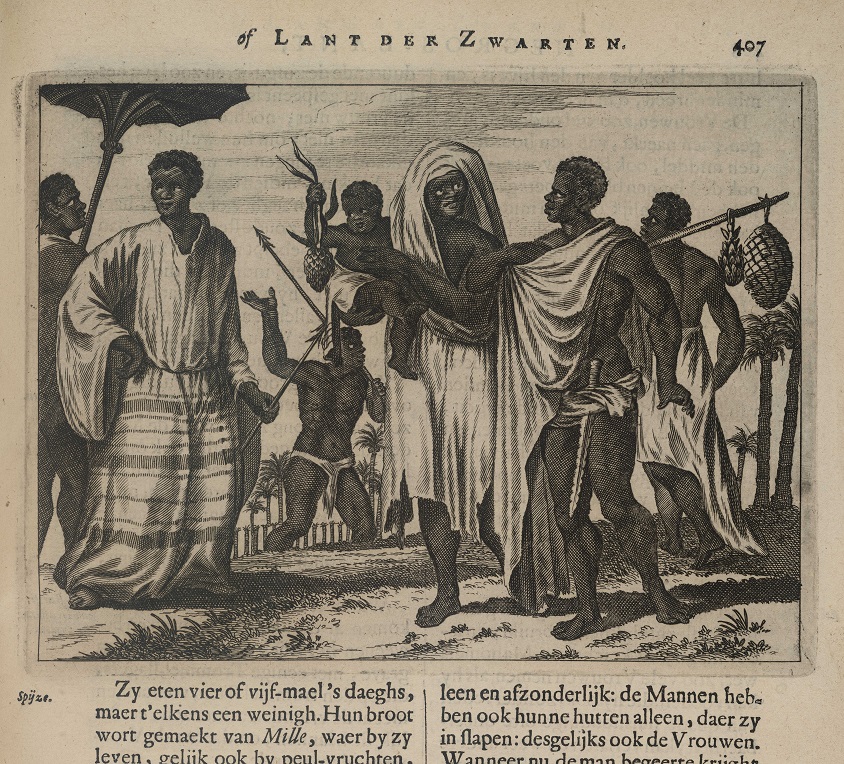West Africa
Famke Visser
This contribution is published in both Dutch and English. You will find the English version below.
| Nummer Koeman’s Atlantes Neerlandici, vol. II | 8750:2 |
| Titel kaart / Titel tekst | NIGRITARVM REGIO / ’t Landt der Mooren Oft Swarten |
’t Landt der Swarten oft Mooren, oftewel de regio West-Afrika, kende in de zeventiende eeuw veel interactie met Europese zeevarende naties. Het waren aanvankelijk de Portugezen die vanaf de vijftiende eeuw de kusten verkenden. Op de kaart van Blaeu is dit duidelijk terug te zien in de plaatsnamen. Vanaf begin zeventiende eeuw vestigen ook de Nederlanders zich te West-Afrika en neemt het gebied een belangrijke positie in binnen de zogenaamde Trans-Atlantische handelsdriehoek.
In de beschrijving van West-Afrika geeft Blaeu veel ruimte aan de natuurlijke historie. Enkele pagina’s zijn gewijd aan landschapsbeschrijvingen en de rivieren in het gebied. Een belangrijk thema dat tijdgenoten van Blaeu bezighield was waar de Nijl precies zijn oorsprong had. Omdat de wijze waarop de rivier de Niger buiten de oevers treedt overeenkomt met de wijze waarop de Nijl buiten de oevers treedt, suggereerden sommige auteurs dat er een connectie tussen beide rivieren moest bestaan. Blaeu neemt deze discussie over in zijn regiobeschrijving.
 Olfert Dapper, Naukeurige Beschrijvinge der Afrikaensche Gewesten (Amsterdam: Jacob van Meurs, 1676), p. 407
Olfert Dapper, Naukeurige Beschrijvinge der Afrikaensche Gewesten (Amsterdam: Jacob van Meurs, 1676), p. 407
De naamgeving van de regio mag opmerkelijk klinken, maar is simpel te verklaren: het is een verwijzing naar de huidskleur van de inwoners van West-Afrika. Hoewel de naam van het gebied dus hiernaar verwijst, valt het op dat er in de Grooten Atlas verder maar enkele keren wordt gesproken over het feit dat de huidskleur van de bevolking ‘peckswart’ is.
Een ander thema waar relatief veel aandacht voor is in Blaeu’s beschrijving van West-Afrika betreft religie, of het vermeende gebrek hieraan. Zo worden de inwoners van het land Nubië (een gebied dat overlapt met het huidige Egypte en Soedan) beschreven als christenen, maar wordt hierbij benadrukt dat deze vorm van christendom compleet verschilt van de protestantse richting. Een belangrijke bron voor Blaeu voor West-Afrika vormde het werk Della descrittione dell’Africa et delle cose notabili che ivi sono (1556) (Nederlands: De beschrijving van Afrika en de noemenswaardige dingen die daar zijn) van reiziger en schrijver Leo Africanus (ca. 1494-1554). We zien in passages dat Blaeu bijna letterlijk de tekst van Africanus kopieert. Eén van deze passages is bijvoorbeeld een beschrijving van Borno, waar volgens Blaeu de inwoners ‘leven als d’onvernuftige dieren’ door hun gebrek aan religie, een beschrijving die Africanus ook al gaf.
Suggestie om verder te lezen:
Cannon, K.G. (2008). “Christian imperialism and the transatlantic slave trade,” Journal of Feminist Studies in Religion, 24(1), pp. 127–134.
| Koeman’s Atlantes Neerlandici, vol. II | 8750:2 |
| Title of map / Title of the text | NIGRITARVM REGIO / ’t Landt der Mooren Oft Swarten |
There was significant interaction between the regions encompassed by the Region of the Blacks, which is present-day West Africa, and European seafaring nations in the seventeenth century. In the fifteenth century, Portuguese explorers were the first Europeans to make contact with West African coastal regions. This is clearly reflected in the place names Blaeu uses in his map of the region. In the early seventeenth century, the Dutch also started to settle in West Africa. From then onwards, the region became a hub in the Transatlantic Trade Route, a triangular trading route that joined the Americas, Africa, and Europe together.
In his description of West Africa, Blaeu focuses heavily on the region’s natural history, devoting a number of pages to its physical features, such as the landscape and rivers. At the time, Blaeu’s contemporaries were particularly interested in discovering and confirming the source of the Nile River. Some scholars speculated that the Nile River and the Niger River might be interconnected due to their similar seasonal flooding patterns. Blaeu echoed this hypothesis in his description of the region.
The name of the region might sound inappropriate to our modern ears, but it simply reflected the European perception of West Africa’s inhabitants based on their physical appearance. That said, interestingly, the Atlas Maior only occasionally refers to the fact that the colour of the locals’ skin is ‘peckswart’ [jet black].
Another relatively prominent theme in Blaeu’s description of West Africa is religion, or the alleged lack thereof. The people of Nubia (a region encompassing parts of what is now Egypt and Sudan), for instance, were described as Christians, while stressing that their form of Christianity was entirely different from European Protestantism. For his information about West Africa, Blaeu relied heavily on the book Della descrittione dell’Africa et delle cose notabili che ivi sono [Description of Africa and of the Notable Things Therein Contained] (1556) by traveller and writer Leo Africanus (ca. 1494-1554). In some passages, Blaeu quoted Africanus virtually verbatim. One of these passages is about the Kingdom of Borno where Blaeu – like Africanus before him – claims the peoples live like ‘d’onvernuftige dieren’ [ignorant beasts] due to their lack of religion.
Further reading:
Cannon, K.G. (2008). “Christian imperialism and the transatlantic slave trade,” Journal of Feminist Studies in Religion, 24(1), pp. 127–134.
